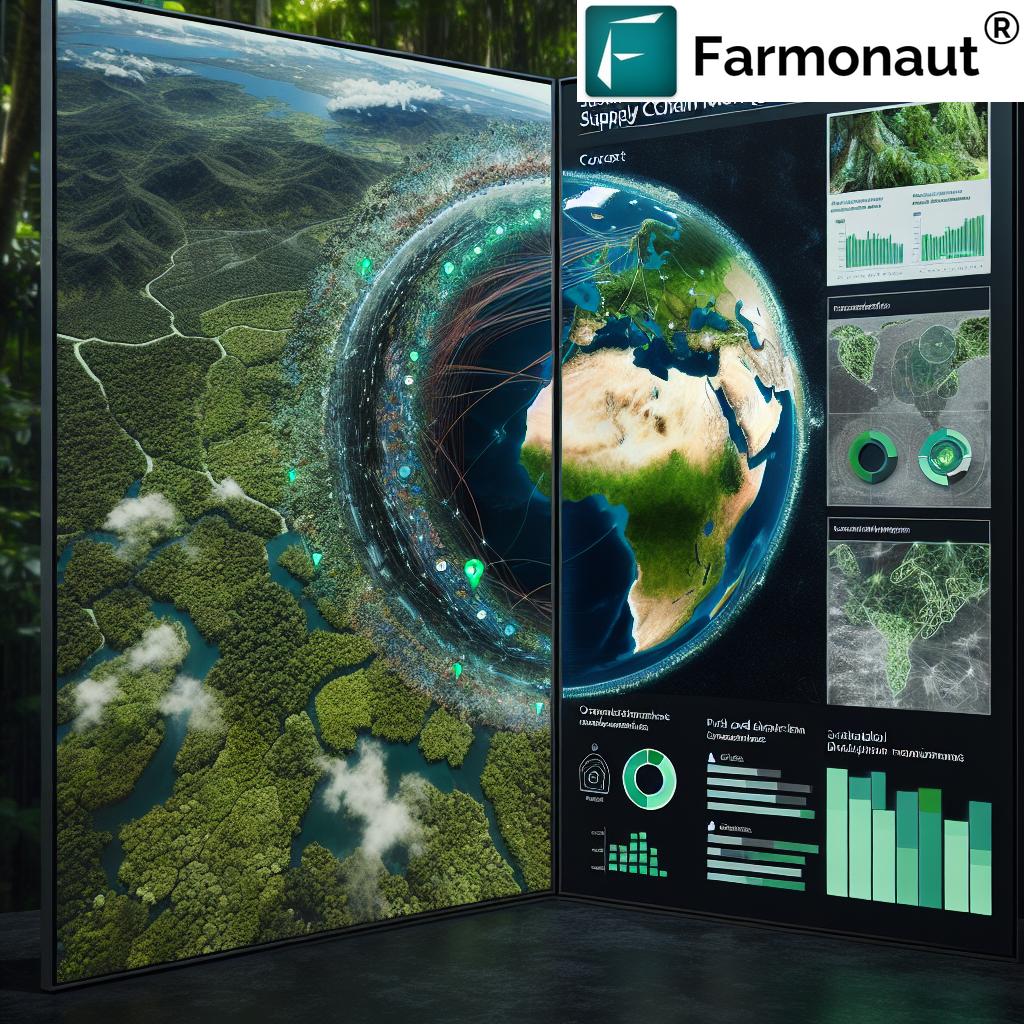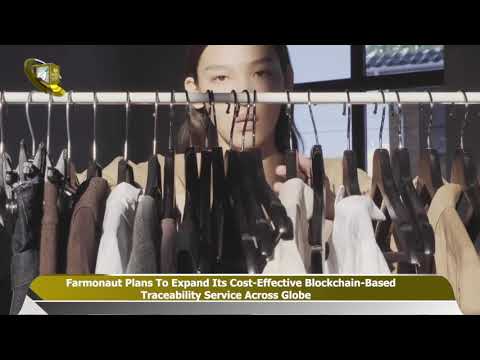Sustainable Luxury: How Data-Driven Deforestation Prevention Revolutionizes Global Supply Chains
“The EU Deforestation Regulation affects companies with a 2022 turnover exceeding €150 million globally or €40 million in the EU.”
In the realm of global sustainability efforts, sustainable deforestation practices and EU Deforestation Regulation compliance have taken center stage. As we delve into this critical topic, we’ll explore how a leading luxury retailer has leveraged forest-risk assessment methods to improve its Forest 500 score and combat tropical deforestation. This case study offers valuable insights into the challenges of supply chain sustainability and innovative approaches to global canopy conservation.
At Farmonaut, we understand the importance of data-driven strategies in environmental conservation. While our focus is on agricultural technology, the principles of sustainability and data analysis are universal. Let’s explore how businesses can utilize these strategies to improve their environmental practices and ensure regulatory compliance.

The Imperative of Sustainable Deforestation Practices
Deforestation remains one of the most pressing environmental challenges of our time. It contributes significantly to climate change, biodiversity loss, and disruption of vital ecosystems. In response to these concerns, governments and organizations worldwide have been implementing stricter regulations and assessment methods to curb deforestation, particularly in tropical regions.
The EU Deforestation Regulation (EUDR) is a prime example of such initiatives. This regulation aims to minimize the EU’s impact on global deforestation by setting stringent requirements for companies importing or exporting specific commodities and products. As the deadline for EUDR compliance approaches, businesses across various sectors are scrambling to adapt their practices and ensure they meet the new standards.
Forest 500: A Benchmark for Corporate Environmental Responsibility
One of the key tools in assessing corporate efforts against deforestation is the Forest 500 ranking. This comprehensive assessment evaluates and ranks the 350 most influential companies and 150 financial institutions in forest-risk commodity supply chains. The Forest 500 score has become a crucial metric for businesses looking to demonstrate their commitment to sustainable practices and improve their environmental impact.
In our case study, we’ll examine how a leading luxury retailer utilized Forest 500 data to drive significant improvements in their environmental practices. By focusing on key areas such as sustainable pulp and paper sourcing, supplier engagement, and leather sourcing, the company was able to make substantial progress in reducing its environmental footprint.
The Role of Data-Driven Strategies in Deforestation Prevention
At the heart of this success story lies the power of data-driven decision-making. By leveraging advanced analytics and forest-risk assessment methods, the luxury retailer was able to gain deep insights into its supply chain and identify areas for improvement. This approach aligns closely with Farmonaut’s mission to make precision agriculture accessible through data-driven insights.
While Farmonaut focuses on agricultural technology, the principles of data analysis and sustainability are applicable across industries. Our satellite-based crop health monitoring and AI-driven advisory systems demonstrate the power of technology in promoting sustainable practices. Similarly, businesses combating deforestation can benefit from advanced data analysis tools to assess risks, track progress, and make informed decisions.
Implementing Sustainable Pulp and Paper Sourcing Strategies
One of the key areas where the luxury retailer made significant strides was in sustainable pulp and paper sourcing. This involved a comprehensive overhaul of their supply chain processes, including:
- Implementing rigorous supplier assessments
- Setting clear sustainability targets for pulp and paper sourcing
- Investing in traceability technologies to ensure transparency
- Collaborating with suppliers to improve their environmental practices
These efforts not only improved the company’s Forest 500 score but also contributed to a significant reduction in their overall environmental impact. The success of this initiative demonstrates the importance of a holistic approach to sustainability that encompasses the entire supply chain.
Enhancing Supplier Engagement for Greater Impact
Another critical factor in the luxury retailer’s success was their focus on enhancing supplier engagement. By fostering closer relationships with their suppliers and providing support for sustainable practices, the company was able to create a ripple effect of positive change throughout their supply chain.
Key strategies in this area included:
- Developing comprehensive supplier guidelines for sustainable practices
- Providing training and resources to help suppliers meet sustainability targets
- Implementing regular audits and assessments to track progress
- Creating incentives for suppliers who demonstrate exceptional environmental performance
This approach not only improved the company’s own environmental footprint but also helped drive industry-wide change by raising standards across their network of suppliers.

Innovative Approaches to Global Canopy Conservation
The luxury retailer’s efforts extended beyond their immediate supply chain to encompass broader initiatives for global canopy conservation. This included:
- Investing in reforestation projects in key regions
- Supporting research into sustainable forestry practices
- Collaborating with NGOs and environmental organizations to drive awareness and action
- Implementing internal policies to reduce paper usage and promote recycling
These initiatives demonstrate the company’s commitment to not just mitigating their own impact, but actively contributing to the preservation and restoration of global forests.
“Forest 500 assesses and ranks the 350 most influential companies and 150 financial institutions in forest-risk commodity supply chains.”
Challenges in Supply Chain Sustainability
While the luxury retailer’s success story is inspiring, it’s important to acknowledge the significant challenges involved in implementing sustainable practices across global supply chains. Some of the key obstacles include:
- Complexity of global supply networks
- Varying regulations and standards across different regions
- Balancing sustainability goals with economic considerations
- Resistance to change from established industry practices
- Difficulties in accurately tracking and verifying sustainability claims
Overcoming these challenges requires a combination of innovative technologies, strong leadership commitment, and collaborative efforts across industries and sectors.
The Impact of EU Deforestation Regulation Compliance
As the deadline for EU Deforestation Regulation compliance approaches, businesses across various sectors are feeling the pressure to adapt their practices. The EUDR sets a new standard for sustainability in global supply chains, with far-reaching implications for companies operating in or trading with the EU.
Key aspects of EUDR compliance include:
- Conducting thorough due diligence on suppliers
- Implementing robust traceability systems
- Ensuring products are deforestation-free and produced legally
- Maintaining comprehensive documentation and reporting
For many companies, achieving EUDR compliance will require significant investments in technology, process improvements, and supplier engagement. However, the long-term benefits of compliance extend beyond regulatory requirements, positioning companies as leaders in sustainability and responsible business practices.
Leveraging Technology for Sustainable Sourcing
Technology plays a crucial role in enabling sustainable sourcing practices and ensuring compliance with regulations like the EUDR. Advanced tools and platforms can help businesses:
- Track and verify the origin of raw materials
- Monitor deforestation risks in real-time
- Analyze supply chain data for sustainability insights
- Streamline reporting and documentation processes
At Farmonaut, we understand the power of technology in driving sustainable practices. While our focus is on agricultural technology, many of the principles we apply in our satellite-based farm management solutions can be adapted to address deforestation challenges. For instance, our approach to real-time crop health monitoring using satellite imagery could be applied to forest monitoring, helping businesses identify and respond to deforestation risks quickly.
For those interested in exploring how technology can support sustainable practices, we invite you to check out our API Developer Docs for insights into integrating advanced satellite and weather data into your systems.
The Business Case for Sustainable Practices
While regulatory compliance is a significant driver for adopting sustainable practices, it’s important to recognize the broader business benefits of these initiatives. Companies that prioritize sustainability and take concrete actions to reduce their environmental impact often see:
- Improved brand reputation and customer loyalty
- Enhanced risk management and resilience
- Cost savings through resource efficiency
- Access to new markets and customer segments
- Increased employee engagement and retention
The luxury retailer in our case study not only improved their Forest 500 score but also strengthened their market position and brand value through their sustainability efforts. This demonstrates that environmental responsibility and business success can go hand in hand.
Forest-Risk Assessment Methods: A Closer Look
The success of the luxury retailer’s deforestation prevention efforts hinged on the effective use of forest-risk assessment methods. These methods involve a comprehensive evaluation of potential deforestation risks throughout the supply chain. Key components of forest-risk assessment include:
- Geospatial analysis to identify high-risk areas
- Supplier risk profiling based on location and practices
- Commodity-specific risk assessments
- Regular monitoring and reporting of key risk indicators
By implementing these assessment methods, businesses can gain a clear understanding of their exposure to deforestation risks and take targeted action to mitigate these risks.
Sustainable Leather Sourcing: A Key Challenge
For luxury retailers, sustainable leather sourcing presents a unique set of challenges. Leather production is often associated with deforestation, particularly in regions where cattle ranching leads to forest clearing. The luxury retailer in our case study addressed this issue through several innovative approaches:
- Implementing strict traceability requirements for leather suppliers
- Investing in alternative, sustainable leather materials
- Supporting regenerative agriculture practices in cattle farming
- Collaborating with industry partners to develop sustainable leather standards
These efforts not only reduced the company’s deforestation footprint but also set new standards for sustainable leather sourcing in the luxury industry.
The Role of Reporting and Transparency
Transparent reporting plays a crucial role in driving sustainable practices and building trust with stakeholders. The luxury retailer’s success was partly due to their commitment to comprehensive and transparent reporting on their sustainability efforts. Key aspects of their reporting strategy included:
- Regular publication of detailed sustainability reports
- Clear communication of targets and progress
- Third-party verification of sustainability claims
- Engagement with stakeholders on sustainability issues
By maintaining a high level of transparency, the company was able to demonstrate their commitment to sustainability and hold themselves accountable for continuous improvement.
Lessons for Businesses: Implementing Data-Driven Sustainability Strategies
The success story of the luxury retailer offers valuable lessons for businesses across industries looking to improve their environmental practices. Here are key takeaways:
- Invest in robust data collection and analysis capabilities
- Set clear, measurable sustainability targets
- Engage suppliers as partners in sustainability efforts
- Leverage technology to enhance traceability and monitoring
- Prioritize transparency and regular reporting
- Collaborate with industry peers and stakeholders to drive systemic change
By adopting these strategies, businesses can not only improve their environmental impact but also position themselves as leaders in sustainable practices.
The Future of Sustainable Supply Chains
As we look to the future, it’s clear that sustainable supply chains will become increasingly critical for business success. Evolving regulations, growing consumer awareness, and the urgent need to address climate change are all driving forces behind this shift. To stay ahead of the curve, businesses must:
- Embrace innovation and new technologies
- Foster a culture of sustainability throughout their organizations
- Anticipate and prepare for future regulatory changes
- Invest in long-term sustainability initiatives
- Collaborate across industries to tackle systemic challenges
At Farmonaut, we’re committed to supporting sustainable practices through our advanced agricultural technologies. While our focus is on precision agriculture, many of the principles we apply can be adapted to support sustainable supply chain management across industries.
For those interested in exploring how technology can support sustainable agriculture practices, we invite you to check out our mobile applications:
Conclusion: Revolutionizing Global Supply Chains Through Data-Driven Sustainability
The case study of the luxury retailer’s journey towards sustainable deforestation practices offers a compelling example of how data-driven strategies can revolutionize global supply chains. By leveraging forest-risk assessment methods, implementing sustainable sourcing strategies, and enhancing supplier engagement, businesses can make significant strides in reducing their environmental impact and improving their sustainability performance.
As the deadline for EU Deforestation Regulation compliance approaches, it’s clear that businesses across industries must prioritize sustainable practices to remain competitive and compliant. The success story we’ve explored demonstrates that with commitment, innovation, and the right technological tools, it’s possible to achieve substantial improvements in environmental performance while also driving business success.
At Farmonaut, we’re proud to be at the forefront of technological innovation in sustainable agriculture. While our focus is on precision farming, we believe that the principles of data-driven decision-making and sustainability that we champion can be applied across industries to drive positive environmental change.
As we move forward, the integration of advanced technologies, robust data analysis, and committed sustainability efforts will be key to creating truly sustainable and resilient global supply chains. By embracing these approaches, businesses can not only meet regulatory requirements but also position themselves as leaders in the global movement towards a more sustainable future.
Forest-Risk Assessment Metrics Comparison
| Metric | Pre-Implementation | Post-Implementation |
|---|---|---|
| Forest 500 Score | 60 | 85 |
| Deforestation Risk (%) | 15% | 5% |
| Supplier Engagement Rate (%) | 40% | 80% |
| Sustainable Pulp Sourcing (%) | 30% | 90% |
| EUDR Compliance Readiness (%) | 20% | 95% |
FAQ Section
Q: What is the EU Deforestation Regulation (EUDR)?
A: The EUDR is a regulation aimed at minimizing the EU’s impact on global deforestation by setting strict requirements for companies importing or exporting specific commodities and products.
Q: How does the Forest 500 ranking work?
A: Forest 500 assesses and ranks the 350 most influential companies and 150 financial institutions in forest-risk commodity supply chains based on their policies and practices related to deforestation.
Q: What are some key strategies for implementing sustainable pulp and paper sourcing?
A: Key strategies include rigorous supplier assessments, setting clear sustainability targets, investing in traceability technologies, and collaborating with suppliers to improve their practices.
Q: How can businesses enhance supplier engagement for sustainability?
A: Businesses can enhance supplier engagement by developing comprehensive guidelines, providing training and resources, implementing regular audits, and creating incentives for exceptional environmental performance.
Q: What role does technology play in sustainable sourcing?
A: Technology enables tracking and verification of raw material origins, real-time monitoring of deforestation risks, supply chain data analysis, and streamlined reporting processes.
Q: What are the business benefits of adopting sustainable practices?
A: Benefits include improved brand reputation, enhanced risk management, cost savings through efficiency, access to new markets, and increased employee engagement.
Q: How can businesses prepare for EUDR compliance?
A: Businesses can prepare by conducting thorough due diligence on suppliers, implementing robust traceability systems, ensuring products are deforestation-free and legally produced, and maintaining comprehensive documentation and reporting.
Explore Farmonaut’s Solutions
While Farmonaut specializes in agricultural technology, our commitment to sustainability and data-driven solutions aligns with the principles discussed in this case study. To learn more about how our technologies can support sustainable practices in agriculture, visit our web application:






